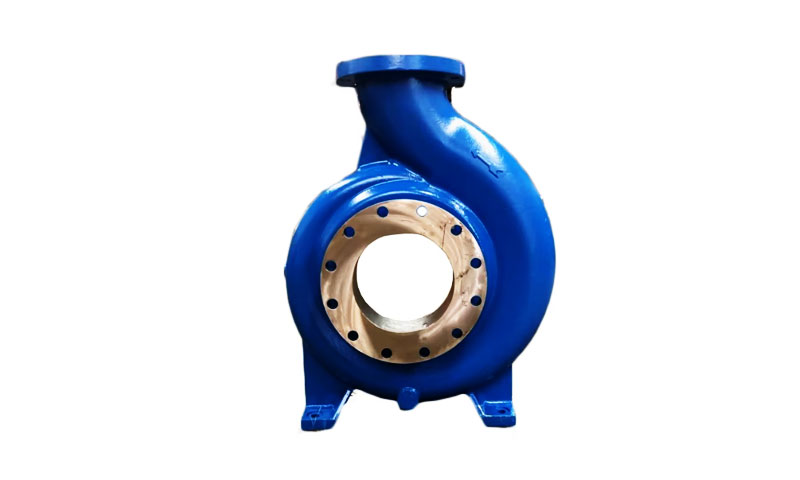1. مقدمة
Pump bodies are structural and hydraulic housings that convert driver energy into fluid motion. They commonly contain volutes, impeller seats, bearing bosses, flanges and internal passages.
The manufacturing route chosen for a pump body sets achievable geometry, المعادن, cost and lead time.
Investment casting stands out where geometry is complex (internal guide vanes, thin webs, integrated bosses), tolerances are tight, and high-integrity alloys (فولاذ مقاوم للصدأ, سبائك النيكل, البرونز) مطلوب.
2. What Is an Investment Casting Pump Body?
Definition and core functionality
و صب الاستثمار pump body is a pump housing produced by the lost-wax (استثمار) طريقة الصب.
A wax (أو البوليمر) pattern of the pump body is created, coated in refractory ceramic to build a shell, the wax removed by heating, and molten metal poured into the ceramic mold.
The fired shell is broken away after solidification to reveal a near-net cast pump body that is subsequently finished and inspected.
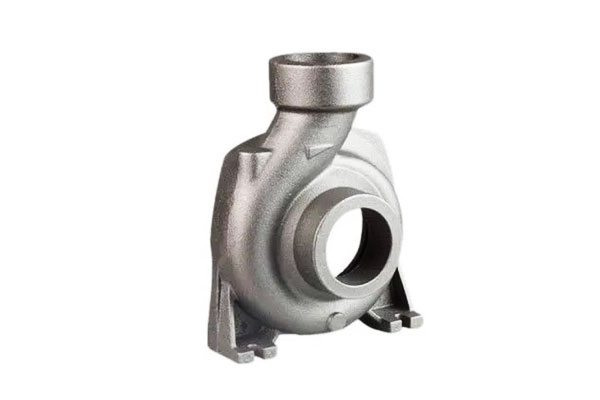
Typical specifications and dimensions
- Part mass: investment cast pump bodies usually range from a few hundred grams to tens of kilograms per piece; many foundries routinely cast pump bodies from ~0.5 kg up to ~50–100 kg depending on plant capability.
- سمك الجدار: typical nominal walls for stainless or nickel alloys: 3-12 مم; minimum thin sections down to 1-2 مم are achievable in selected alloys and process control.
- التسامح الأبعاد (كما): general investment cast tolerances commonly fall in ± 0.1-0.5 مم for small features; percent-based tolerance of ±0.25–0.5% linear is a practical rule of thumb.
Critical machined features are usually left with machining allowance (0.2–2.0 mm depending on casting accuracy). - الانتهاء من السطح (كما): typical Ra 1.6-3.2 ميكرون (50-125 دقيقة) for standard ceramic shells; fine shells and careful pouring can produce Ra ≈ 0.8–1.6 μm.
Sealing faces or bearing journals are machined/lapped to much finer Ra (≤ 0.2 μM) as required.
3. اعتبارات التصميم
Investment casting enables complex geometry, but good design practice maximizes quality and minimizes cost.
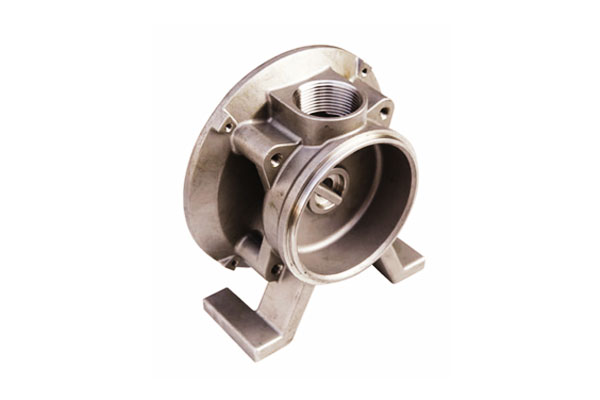
Hydraulic performance requirements
- Flow passages & volutes: smooth fillets and controlled convergence avoid separation and cavitation.
Internal fillet radii should be generous (≥ 1–2× wall thickness) to reduce turbulence. - Impeller seat alignment: concentricity and perpendicularity are critical — plan for machined bores and datum features.
- Clearances: pump clearances at impeller overhangs and seal faces must be maintainable by post-cast machining.
Structural requirements
- Stress & تعب: consider cyclical loads; use finite-element analysis to identify local stress risers.
Cast metallurgy (حجم الحبوب, الفصل) affects fatigue life—design to avoid thin, highly stressed bosses without proper filleting. - Vibration: stiff webs and ribs help raise natural frequencies; investment casting allows ribs to be integrated into the body.
تآكل & يرتدي
- اختيار المواد: choose alloy based on fluid chemistry (PH, الكلوريد, الجسيمات التآكل, درجة حرارة).
For seawater, duplex or cupronickel may be required; for acids, Hastelloy or appropriate nickel alloys. - Erosion resistance: smooth internal surfaces and sacrificial coatings (الصلب, رذاذ حراري) are options where particulate slurry is present.
تحمل الأبعاد & الانتهاء من السطح
- ميزات حرجة: designate which faces/bores are finish-machined and specify machining allowances (على سبيل المثال, 0.5–1.5 mm for sandier shells, 0.2–0.6 mm for precision shells).
- Sealing surfaces: specify Ra and flatness; often lapped/polished to Ra ≤ 0.2 μm and flatness within 0.01-0.05 مم depending on pressure class.
4. Materials for Investment Casting Pump Bodies
Material selection is a critical factor in designing and producing investment-cast pump bodies, as it directly affects mechanical performance, مقاومة التآكل, التصنيع, وخدمة الحياة.
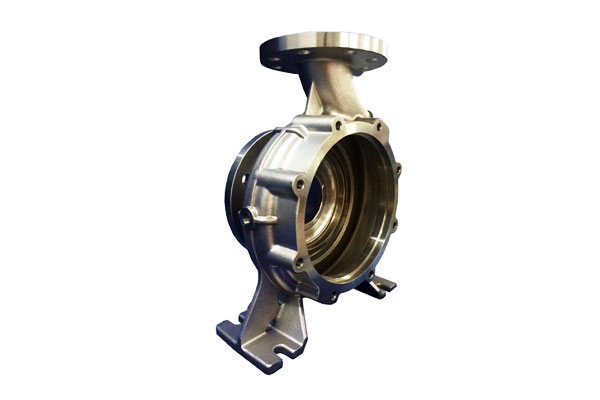
| فئة المواد | مثال السبائك | الخصائص الرئيسية | التطبيقات النموذجية | إلقاء الاعتبارات |
| أوستنيتي الفولاذ المقاوم للصدأ | 304, 316ل | مقاومة تآكل ممتازة, قوة معتدلة, قابلية اللحام الجيدة; الشد: 480-620 ميجا باسكال, أَثْمَر: 170-300 ميجا باسكال, استطالة: 40-60 ٪ | General chemical pumps, معالجة المياه, طعام & المشروبات | Good molten fluidity, low hot-cracking risk, easy post-machining |
| دوبلكس ستانلس ستيل | 2205, 2507 | قوة عالية (Yield 450–550 MPa), superior chloride stress corrosion resistance | Marine and offshore pumps, البيئات الكيميائية العدوانية | Requires controlled temperature; post-casting heat treatment to prevent sigma phase |
سبائك النيكل |
Inconel 625, 718; هاستلوي | مقاومة تآكل استثنائية, قوة درجة الحرارة العالية, مقاومة الأكسدة | المعالجة الكيميائية, توليد الطاقة, زيت & الغاز | High melting points (≈1450–1600 °C); careful mold preheating and controlled pouring needed; difficult machining |
| البرونز and Copper Alloys | C93200, C95400 | مقاومة تآكل مياه البحر ممتازة, مقاومة ارتداء جيدة, antifouling; قوة ميكانيكية أقل | المضخات البحرية, تبريد مياه البحر, المكونات الهيدروليكية | Lower melting points (≈1050–1150 °C) simplify casting; low thermal cracking risk; mechanical strength lower than stainless/nickel |
5. Investment Casting Process for Pump Bodies
صب الاستثمار, المعروف أيضا باسم صب الشمع المفقود, enables the production of pump bodies with complex geometries, الجدران الرقيقة, ودقة أبعاد عالية.
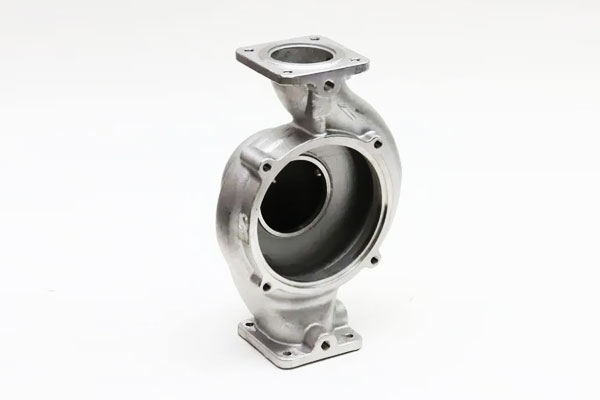
The process consists of several critical steps:
| خطوة | وصف | اعتبارات رئيسية |
| 1. خلق نمط الشمع | Molten wax is injected into precision molds to form replicas of the pump body. | Ensure uniform wall thickness; maintain dimensional accuracy ±0.1 mm; use high-quality wax to prevent distortion. |
| 2. Assembly of Wax Tree | Individual wax patterns are attached to a central wax sprue to form a tree for batch casting. | Sprue design affects metal flow; minimize turbulence during pouring. |
| 3. مبنى شل السيراميك | Repeated dipping in ceramic slurry and stuccoing with fine refractory sand creates a strong, قذيفة مقاومة للحرارة. | Target shell thickness (5-10 مم) depends on pump body size; avoid cracks and porosity in the shell. |
| 4. Dewaxing and Mold Firing | Wax is melted out (autoclave or kiln), ترك تجويف; the ceramic shell is then fired to remove residues and strengthen the mold. | Temperature ramping must be controlled to prevent shell cracking; residual wax must be fully removed. |
5. صب المعادن |
معدن منصهر (الفولاذ المقاوم للصدأ, nickel alloy, أو البرونز) is poured into the preheated ceramic mold under gravity or vacuum-assisted conditions. | Pouring temperature and rate must ensure complete filling; control turbulence and prevent oxide formation. |
| 6. التصلب والتبريد | Metal solidifies inside the mold; cooling rates affect microstructure, الخصائص الميكانيكية, والإجهاد المتبقي. | Thick sections may require controlled cooling to prevent porosity; thin walls must avoid hot tearing. |
| 7. إزالة الصدفة | Ceramic shell is broken away mechanically, often using vibration, sand blasting, or chemical dissolution. | Avoid damaging intricate pump channels or flanges. |
| 8. Finishing and Cleaning | Residual ceramic, gating system, and surface imperfections are removed via grinding, إطلاق النار, or chemical cleaning. | Maintain dimensional tolerances; prepare surfaces for subsequent machining or coating. |
6. عمليات ما بعد الصب
After the pump body is removed from the ceramic shell, several post-casting operations are performed to ensure the component meets functional, الأبعاد, ومتطلبات جودة السطح.
These operations are critical for high-performance applications in chemical, البحرية, والقطاعات الصناعية.
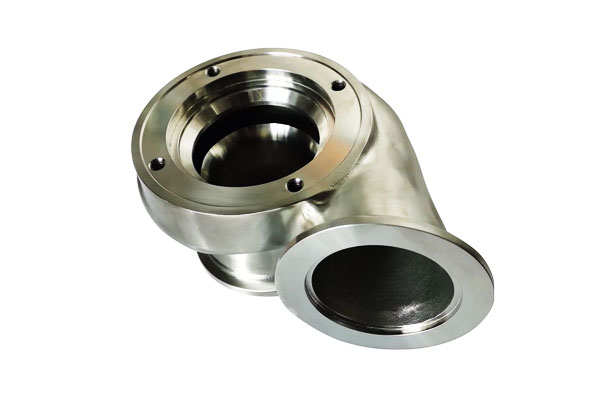
المعالجة الحرارية
المعالجة الحرارية is applied to relieve residual stresses, تحسين ليونة, and optimize mechanical properties:
- الإجهاد تخفيف الصلب: Heating to 550–650 °C for stainless steels reduces residual stress from casting and prevents distortion during machining.
- الحل الصلب: Applied for stainless steels and nickel alloys to homogenize microstructure and dissolve unwanted precipitates, ensuring corrosion resistance and consistent hardness.
- Aging or Precipitation Hardening (for certain alloys): Enhances strength and wear resistance in high-performance materials.
الآلات
Critical dimensions such as flanges, بورز, mating surfaces, and threaded ports are machined to meet tight tolerances.
Typical machining operations include turning, الطحن, حفر, and boring. Machining ensures:
- Dimensional tolerances of ±0.05–0.1 mm for precise assembly.
- Smooth sealing surfaces to prevent leaks in high-pressure applications.
التشطيب السطح
التشطيب السطح يعزز مقاومة التآكل, ارتداء المقاومة, والجماليات:
- تلميع: Improves smoothness for sealing faces and internal channels.
- إطلاق النار: Removes residual ceramic particles and creates a uniform surface for coating or painting.
- الطلاء: Optional chemical or electroplated coatings (على سبيل المثال, النيكل, PTFE) enhance corrosion resistance and reduce friction.
اختبار غير التدمير (NDT)
To detect defects such as porosity, تشققات, أو الادراج, NDT is performed:
- التصوير الشعاعي (الأشعة السينية): Identifies internal voids and inclusions.
- اختبار الموجات فوق الصوتية (يوت): Detects subsurface flaws in thick sections.
- اختبار اختراق الصبغة (حزب العمال): Reveals surface cracks and porosity.
Cleaning and Inspection
أخيراً, pump bodies are cleaned to remove residual machining oils, حطام, or salts. Dimensional and visual inspections verify compliance with specifications before assembly or shipment.
7. Quality Assurance and Testing
ضمان الجودة (QA) is critical in ensuring that investment casting pump bodies meet design specifications, performance standards, ومتطلبات الصناعة.
A systematic QA approach combines dimensional checks, الاختبار الميكانيكي, and non-destructive evaluation to detect defects and confirm functional integrity.
التفتيش الأبعاد
Dimensional verification ensures that the pump body conforms to design drawings and tolerances:
- تنسيق آلات القياس (CMM): Measure complex geometries, بورز, الشفاه, and mounting surfaces with accuracy of ±0.01–0.05 mm.
- Gauge Tools: Thread gauges, plug gauges, and height gauges verify critical features quickly in production.
- قياس خشونة السطح: Confirms finishing requirements for sealing faces and internal channels (على سبيل المثال, Ra ≤0.8 μm for hydraulic components).
Mechanical Property Verification
Mechanical testing validates that the material meets required strength, ليونة, والصلابة:
- اختبار الشد: Measures yield strength, قوة الشد النهائية, واستطالة, ensuring the material can withstand operational loads.
- اختبار الصلابة: Rockwell or Vickers testing confirms that heat treatment and material processing achieved the desired hardness.
- اختبار التأثير (إذا لزم الأمر): Evaluates toughness for applications exposed to fluctuating loads or shock.
اختبار غير التدمير (NDT)
NDT techniques detect hidden defects without damaging the part:
- التصوير الشعاعي (X-ray/CT Scanning): Identifies internal porosity, الادراج, and voids, particularly in thick sections.
- اختبار الموجات فوق الصوتية (يوت): Detects internal cracks, الفراغات, or delaminations in dense materials like stainless steel and nickel alloys.
- اختبار اختراق الصبغة (حزب العمال): Reveals surface cracks, الثقوب, or fine porosity not visible to the naked eye.
- اختبار الجسيمات المغناطيسية (MT): Applied for ferromagnetic alloys to detect surface and near-surface discontinuities.
Common Casting Defects and Mitigation Strategies
- المسامية: Minimized through proper gating, تنفيس, and controlled solidification rates.
- تجاويف الانكماش: Addressed via riser design and thermal management.
- يغلق البرد ويسيء الطعن: Avoided by maintaining optimal pouring temperatures and smooth flow in complex geometries.
- Surface Inclusions: Controlled by using high-purity alloys and proper degassing techniques.
8. Advantages of Investment Casting for Pump Bodies
- الهندسة المعقدة: مقاطع داخلية, thin walls and integrated bosses with minimal secondary assembly.
- شكل شبه شبكة: reduces material removal vs. rough machining from bar or billet — often 30–70% less machining للأجزاء المعقدة.
- دقة أبعاد عالية & الانتهاء من السطح: less secondary finishing for many features compared with sand casting.
- Alloy flexibility: cast many stainless and nickel alloys with good metallurgical integrity.
- Small to medium production flexibility: tooling for wax patterns is relatively inexpensive vs. large die tooling, enabling economic runs from prototypes to thousands of parts.
9. القيود والتحديات
- Cost for very large parts: above certain sizes (غالباً >100 كجم) investment casting becomes uneconomical compared with sand casting or fabricating/ welding.
- مهلة: pattern tooling, shell building and firing add lead time—prototype timelines usually measured in weeks.
- Porosity risk in thick sections: thick bosses or large cross-sections require careful gating, chills or segmenting to avoid shrinkage.
- Surface finish and tolerances depend on shell system: achieving ultra-fine finishes or extremely tight as-cast tolerances requires premium ceramic systems and process control.
10. التطبيقات الصناعية
Investment casting pump bodies are used across a broad spectrum of industries due to their complex geometry capabilities, براعة المواد, ودقة أبعاد عالية.
The process allows engineers to design optimized hydraulic passages, الجدران الرقيقة, and integrated mounting features that improve pump efficiency and longevity.
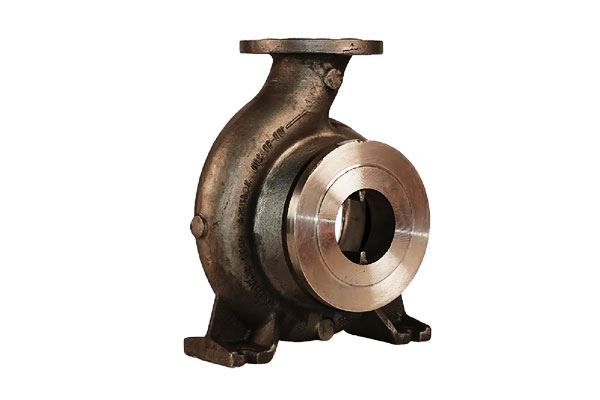
Chemical Processing Pumps
- بيئة: Corrosive fluids such as acids, caustics, والمذيبات.
- Materials Used: فولاذ مقاوم للصدأ (316ل, دوبلكس) and nickel alloys (هاستلوي, Inconel).
- الأساس المنطقي: Investment casting enables intricate internal channels, minimizing turbulence and ensuring uniform flow, critical for chemical process reliability.
Water and Wastewater Pumps
- بيئة: High-volume pumping, abrasive suspended solids, and variable pH levels.
- Materials Used: البرونز, مزدوجة الفولاذ المقاوم للصدأ, and corrosion-resistant cast irons.
- الأساس المنطقي: Thin-wall, smooth internal passages reduce clogging and energy losses, improving efficiency in municipal and industrial water systems.
Marine and Offshore Pumps
- بيئة: Saltwater exposure, high-pressure operation, and cyclical mechanical stress.
- Materials Used: سبائك النحاس (النحاس البحري, البرونز), دوبلكس فولاذ مقاوم للصدأ.
- الأساس المنطقي: Resistance to corrosion and biofouling is critical; investment casting allows seamless, complex geometries to reduce maintenance and improve service life.
زيت & Gas and Power Generation Pumps
- بيئة: درجة حرارة عالية, high-pressure fluids, and hydrocarbon-based media.
- Materials Used: High-nickel alloys (Inconel, هاستلوي), الفولاذ المقاوم للصدأ, and cobalt-based alloys.
- الأساس المنطقي: Investment casting supports high-strength materials and precise tolerances necessary for critical applications such as turbine lubrication, الحقن الكيميائي, and offshore drilling.
Specialty and Custom Pumps
- بيئة: Laboratory, الأدوية, or food processing applications requiring hygienic and precision performance.
- Materials Used: الفولاذ المقاوم للصدأ (304, 316ل), التيتانيوم, أو سبائك النيكل.
- الأساس المنطقي: أسطح ناعمة, التحمل الصارم, and complex geometries achieved by investment casting ensure minimal contamination risk and compliance with regulatory standards.
11. التحليل المقارن
| ميزة / معايير | صب الاستثمار | صب الرمال | Machining from Solid |
| التعقيد الهندسي | Excellent – thin walls, القنوات الداخلية, intricate features achievable | Moderate – limited by core placement and mold stability | Limited – complex internal geometries often impossible without assembly |
| دقة الأبعاد | High – ±0.1–0.25 mm typical | Moderate – ±0.5–1.0 mm | Very High – ±0.05 mm achievable |
| الانتهاء من السطح (ر) | Fine – 1.6–3.2 μm typical; can be polished | Rough – 6–12 μm; requires machining for precision | Excellent – 0.8–1.6 μm achievable with finishing |
| خيارات المواد | Wide – stainless steels, سبائك النيكل, البرونز, سبائك النحاس | Wide – iron, فُولاَذ, البرونز, الألومنيوم | Wide – depends on machinable stock availability |
| حجم الدُفعة | Low-to-medium – 1–1000+ parts | Medium-to-high – economical for large, أجزاء بسيطة | Low – material waste increases cost for large parts |
| مهلة | Moderate – wax pattern & shell building required | Short-to-moderate – mold preparation relatively quick | Variable – depends on machining complexity |
نفايات المواد |
Low – near-net shape reduces scrap | Moderate – gating and risers generate some waste | High – subtractive process creates chips and offcuts |
| التكلفة لكل جزء | Moderate-to-high – tooling and process steps increase cost, economical for complex parts | Low-to-moderate – simpler molds, larger parts cheaper | High – extensive machining on large, complex parts is expensive |
| قوة & نزاهة | Excellent – dense microstructure, minimal porosity if controlled | Moderate – risk of sand-related inclusions and porosity | Excellent – homogeneous, لا عيوب صب |
| Post-Processing Required | Often minimal – some machining, الانتهاء | Usually significant – machining and finishing required | Minimal – final finishing for tight tolerances only |
| التطبيقات النموذجية | Pump bodies with thin walls, complex hydraulic channels, مقاومة التآكل | كبير, simple pump housings or structural components | Custom or prototype pump bodies requiring extreme precision |
12. خاتمة
Investment casting pump body combines design freedom with metallurgical integrity, making them an excellent choice for many fluid-handling applications—especially where complex internal geometry, exotic alloys or tight tolerances are required.
Success depends on early design for casting, informed material selection, careful process control (سكب, shelling, المعالجة الحرارية), and robust QA/NDT programs.
For critical pump systems—marine, chemical or power generation—investment casting can deliver reliable, economical components when specified and executed correctly.
الأسئلة الشائعة
What maximum size of pump body can be investment cast?
Typical shop practice ranges up to ~50–100 kg per part, but the practical maximum depends on foundry capability and economics.
Very large pump bodies are more often produced by sand casting or fabricating/welding.
How much machining allowance should I design into an investment casting?
يسمح 0.2-2.0 مم depending on the criticality and shell precision. Specify tighter allowances only where the foundry guarantees precision shells.
Which material is best for seawater pump bodies?
Duplex stainless steels and selected copper-nickel alloys are common choices due to superior chloride pitting resistance and biofouling performance; final selection depends on temperature, velocity and erosion conditions.
What is the typical turnaround time for an investment-cast pump body?
Small production runs typically take 4-8 أسابيع from pattern approval to finished parts; single prototypes can be faster with 3D-printed patterns but still require shell firing and melt schedules.
How do I specify acceptance criteria for porosity?
Use industry NDT standards (التصوير الشعاعي, CT, يوت) and define acceptance levels in percent porosity by volume or via reference images.
Critical pressure-retaining pump bodies often require porosity <0.5% by volume and radiographic acceptance per customer standard.
